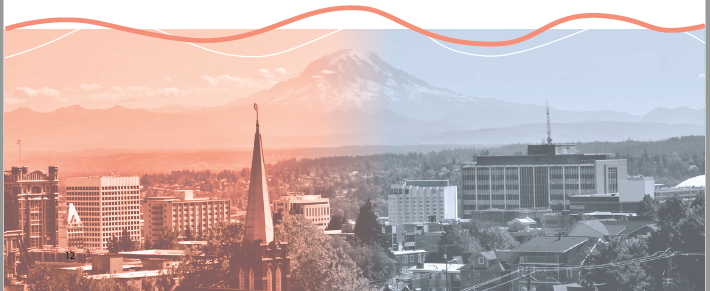
Local Climate Impacts
“Part of what the city needs to do is coordinate efforts to ensure that the most vulnerable are protected against the worst impacts of climate change-excessive heat, wildfire smoke exposure, etc.”
Tacoma community member
Tacoma is now experiencing extreme weather and worsening environmental and public health conditions as a result of climate change. Conditions will worsen unless urgent climate action is taken. Expected local climate impacts are listed below:
- More very hot days
- Reduced snowpack
- Lower summer streamflow
- Higher winter streamflow
- Sea level rise
- Ocean acidification
- Stresses on salmon, shellfish, and other species
- Reduced recreation
- More wildfires and smoke
- Worse air quality
- Increased flooding
- Reduced agriculture yield
The City of Tacoma is continuing to invest in a climate-resilient and climate-smart future by building on our long history of climate action. The Tacoma Adaptation Strategy, summarized in the table below, provides a blueprint and
foundation for the City of Tacoma to adapt to future climate risks and achieve its vision of a
sustainable and resilient Tacoma. The Strategy’s actions will reduce exposure to climate hazards, ensure
that capital investments can withstand future climate change, protect our native habitats, build economic
resilience and prosperity, support a diverse community with services and amenities, and enhance the
health and well-being of current and future generations.
| Sector |
Strategies |
Actions |
| Infrastructure |
- Improve building resilience
- Improve transportation resilience
- Improve water & energy infrastructure
resilience
- Improve cross-sectoral infrastructure
resilience
|
- Site-by-site flooding evaluation and planning
- Capital project standards and tools
- Development code improvements
- Capital project planning and prioritization, and
implementation
|
|
Natural Systems
|
- Improve ecosystem resilience
- Ensure a health and sufficient water supply
|
- Natural systems condition assessment and
monitoring program
- Nearshore transitional zones
- Habitat restoration project guidance and
resilience
|
| Economy |
- Build resilient and adaptable industries
- Build a resilient and effective workforce
|
- Business engagement and continuity planning
- Just & green jobs transition plan
|
| Public Health |
- Minimize climate-related health impacts
- Increase social cohesion
- Prepare for weather emergencies
|
- Cooling and air quality resilience hubs
- Co-create climate communications
- Filter fan distribution
|
| Governance |
- Equip residents and businesses with
resources to successfully adapt
- Increase City accountability
- Build regional, comprehensive resilience
|
- Climate equity initiatives
- Regional coordination
- Economic return-on-investment tools
|
Climate Resiliency
The impacts of climate change threaten Tacoma’s natural systems, built environment, and the health and safety of our community. In order to better understand and proactively manage climate risks, the City of Tacoma undertook a Climate Change Resilience Study in 2016. With these findings, the City will be better able to protect local residents, make sound investments, and ensure that our community can prosper, even in the face of a changing climate.
Explore Tacoma’s Climate Resilience Study and the graphics below to learn more about Tacoma’s climate readiness and to find out what you can do to fight the impacts of climate change.
Tacoma Adaptation Strategy
2016 Executive Summary of Climate Resilience Study
2016 Climate Resilience Study Full Report
The Washington Coastal Resilience Project
The Washington Coastal Resilience Project (WCRP) is a three-year effort to rapidly increase the state’s capacity to prepare for natural events that threaten the coast. The project will improve risk projections, provide better guidance for land use planners and strengthen capital investment programs for coastal restoration and infrastructure. These are the tools that coastal communities need to become more resilient to disasters.
“It’s time to start acting: do some pilots, some projects based on data and research available to get results, then adjust and continue accordingly.”
Tacoma community member
Climate Investments & Cost Savings
The City estimates that the community needs to invest as much as $2.5 billion to achieve Tacoma’s 2050 climate goal and avoid damages and achieve efficiency savings that exceed $3.4 - $6.7 billion, with a potential net savings of more than $4 billion. The City is committed to making major climate action investments and will also rely on partnerships with and initiative from local public agencies, private sector organizations, and everyday community members.
See the City’s detailed financial analysis and potential funding options to support Plan implementation.